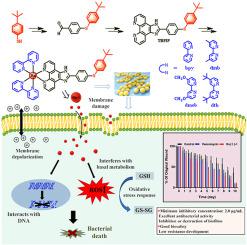European Journal of Medicinal Chemistry ( IF 6.0 ) Pub Date : 2022-06-25 , DOI: 10.1016/j.ejmech.2022.114562 Zhang ChunYan 1 , Yu RuJian 1 , Wang LiQiang 1 , Huang HaiYan 1 , Wang JinTao 1 , Liao XiangWen 1 , Duan XueMin 1 , Xiong YanShi 1

|
With the increase in bacterial resistance, new antimicrobial agents are urgently need for developing to combat multidrug-resistant pathogens and with low cytotoxicity. In this study, four new ruthenium polypyridine complexes bearing 4-tBu-phenyl sulfide Ru(bpy)2(TBPIP)](PF6)2 (Ru(Ⅱ)-1), Ru(dmb)2(TBPIP)](PF6)2 (Ru(Ⅱ)-2), Ru(dmob)2(TBPIP)](PF6)2 (Ru(Ⅱ)-3) and Ru(dtb)2(TBPIP)](PF6)2 (Ru(Ⅱ)-4) were designed, synthesized and evaluated. Those ruthenium complexes showed strong activity against Staphylococcus aureus (S. aureus) in vitro and in vivo. The Ru(Ⅱ)-1 showed excellent antimicrobial activity against Gram-positive bacteria (MIC = 2.0 μg/mL), poor hemolytic activity (HC50 > 200 μg/mL), and low cytotoxicity to mammalian cells. Ru(Ⅱ)-1 can kill bacteria quickly by destroying the bacterial membranes and avoid developing bacterial cross-resistance. Moreover, antibacterial mechanism studies show that Ru(Ⅱ)-1 destroys the integrity of bacterial cell membrane by permeabilization and depolarization of bacterial cell membrane, and interacts with bacterial DNA to produce a large number of ROS to kill bacteria. Importantly, Ru(Ⅱ)-1 exhibited effective in vivo efficacy in the mouse S. aureus infection model. These results indicated that ruthenium polypyridine complexes modified with 4-tBu-phenyl sulfide had the therapeutic potential as a novel membrane-active antimicrobial to combat Gram-positive bacterial infections.
中文翻译:

芳基硫醚钌聚吡啶复合物的设计、合成和评价:一种针对革兰氏阳性菌的多靶点抗菌剂
随着细菌耐药性的增加,迫切需要开发新的抗菌药物来对抗多重耐药病原体和低细胞毒性。在这项研究中,四种新型钌多吡啶配合物含有 4 - t Bu-苯基硫化物 Ru(bpy) 2 (TBPIP)](PF 6 ) 2 (Ru(Ⅱ)-1) , Ru(dmb) 2 (TBPIP)]( PF 6 ) 2 (Ru(Ⅱ)-2) , Ru(dmob) 2 (TBPIP)](PF 6 ) 2 (Ru(Ⅱ)-3)和 Ru(dtb) 2 (TBPIP)](PF 6 ) 2 (Ru(Ⅱ)-4)设计、合成和评估。这些钌配合物在体外和体内均显示出对金黄色葡萄球菌(S. aureus )的强活性。Ru(Ⅱ)-1对革兰氏阳性菌表现出优异的抗菌活性(MIC = 2.0 μg/mL),溶血活性较差(HC 50 > 200 μg/mL),对哺乳动物细胞的细胞毒性低。Ru(Ⅱ)-1可以通过破坏细菌膜快速杀灭细菌,避免产生细菌交叉耐药性。此外,抗菌机制研究表明,Ru(Ⅱ)-1通过细菌细胞膜的透化和去极化作用破坏细菌细胞膜的完整性,与细菌DNA相互作用产生大量活性氧杀死细菌。重要的是,Ru(Ⅱ)-1在小鼠金黄色葡萄球菌感染模型中表现出有效的体内功效。这些结果表明,用 4-叔丁基苯硫醚修饰的多吡啶钌复合物具有作为一种新型膜活性抗菌剂来对抗革兰氏阳性细菌感染的治疗潜力。













































 京公网安备 11010802027423号
京公网安备 11010802027423号